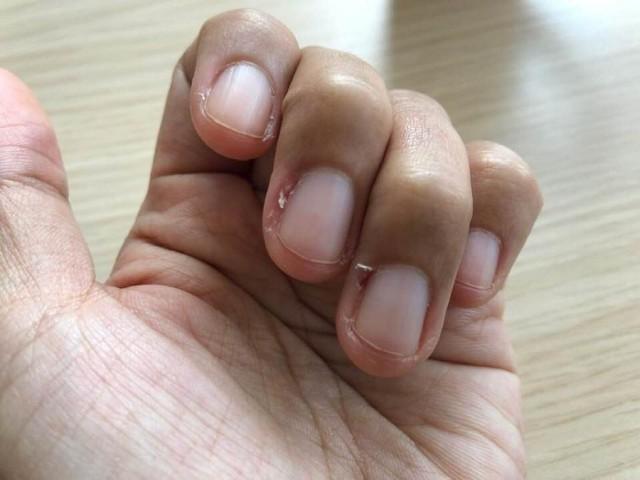How to care for your cuticles and deal with pesky hangnails
To cut or not to cut, that is the question often asked at nail salons when it comes to cuticles.
Because cuticles are there for a purpose and serve an important function, experts say it’s best you leave them alone.

“The cuticle is the layer of skin found at the base of the nail that serves to protect the nail bed,” says Leslie Colleen Acosta Tiongson MD, DPDS, a dermatologist at Metro North Medical Center.
Adds Maria Rica S. Mallari, M.D., head of the Hair Unit of the Dermatology Center and a faculty member at St. Luke’s College of Medicine, “[It] acts like a sealant that protects the root of the nail from entry of pathogens or organisms like bacteria and fungus that may cause [nail disease].”
This is why, Mallari says, you should avoid removing or cutting them when you get manicures. “[This common practice] allows the entrance of pathogenic organisms under the nail fold and into the nail matrix, which may cause swelling, inflammation, and infection,” she explains.
In fact, if what you want are pretty, healthy-looking nails, keeping your cuticles intact is key. So instead of having them cut your cuticles when you’re at the nail salon, Tiongson suggests you ask nail technicians to just gently ‘push’ them.
“Also, make sure you always use sanitized instruments,” she advises.
Aside from not trimming, removing, or manipulating your cuticles, Dr Stephanie Sy-Chua, a fellow of the Philippine Dermatological Society, recommends moisturizing your cuticles regularly.
Tiongson agrees, “Avoidance of trauma to the hands, avoidance of abrasive products and drying agents, as well as frequent application of moisturizers or lotions will help preserve the cuticles.”
Cuticles, by the way, are not to be confused with hangnails. “Hangnails are hardened excess skin usually found on either side of the nail plate at the junction of the nail plate and the nail fold,” says Tiongson.
“These are seen as short strips of the outermost layer of the skin getting lifted up from the normal skin as a result of stretching of the dry skin, which can be annoying and painful,” Mallari adds.
“[It’s painful because] it is like peeling your skin, there's an excoriation,” explains Sy-Chua.
Tiongson says, it doesn’t help that “the fingers have a large amount of nerve endings, [due to the fact that] our fingers do a lot of tactile work for us (touching, feeling, sensing heat, cold or pain), warning us of danger and pain.”
There are certain factors that make one more prone to developing hangnails. Have you ever noticed you get it more when the weather is colder? That’s because your skin is dryer in colder temperatures. So our experts recommend you be extra vigilant with moisturizing your hands when temperatures drop.
Other factors that contribute to hangnails include mechanical trauma and frequent manipulation of the skin surrounding the nails, or the use of harsh chemicals or abrasives.
So frequent manicures, which according to Sy-Chua qualifies as mechanical trauma, is actually inadvisable. Regular, professional nail cleaning from someone who knows what they’re doing is not bad, but if your nail technician is the type who really cares about the condition of your nails, they’ll tell you that getting them done too often is counterproductive.
Finally, add hangnails to the reasons why you should quit your nasty nail-biting habit, if you have one, because aside from being unhygienic and unattractive, Sy-Chua says nails that are constantly wet are more prone to developing hangnails. She warns against thumb sucking, nail biting, and chores that keep the hands wet for long periods.
Another thing you should never do is pull out hangnails. We’ve all done it before. Hangnails are annoying and painful, and it’s hard to ignore them. The problem is you don’t always have nail clippers with you, so sometimes you resort to pulling them out.
You've probably realized immediately how terrible an idea that is. Aside from the excruciating pain, Mallari says pulling out your hangnails may cause swelling, additional discomfort, and could even lead to bacterial or fungal infection.
The best thing you can do is to trim them with nail clippers. “Cut the hangnails up to the base and apply antibacterial cream to prevent infection. [Then] use hand cream after washing your hands,” Mallari advises. You can even soak your fingers in warm water for five minutes before clipping the hangnail to soften it a bit. And if you’re prone to hangnails, maybe carry a small nail clipper with you wherever you go.
Whether it’s keeping your cuticles healthy or preventing hangnails, it’s important to give your hands some TLC by making it a habit to moisturize regularly.
Try, too, to minimize any unnecessary manipulation which, sorry to say, includes manicures. We’re not against manicures per se, but try not to overdo it. And when you do go, remind the technician to leave your cuticles alone. — LA, GMA News

Need a wellness break? Sign up for The Boost!
Stay up-to-date with the latest health and wellness reads.
Please enter a valid email address
Your email is safe with us






